
Dave McAnerney is the chief operating officer for Stober Construction that built the Landmark Centre.
(ROB MUNRO / iNFOnews.ca)
July 30, 2019 - 7:00 AM
KELOWNA - Office towers are often placed in a city's downtown core but Kelowna is an exception with the Landmark District situated three kilometres away from City Hall.
The reason why isn't just happenstance. It all comes down to a document that Al Stober signed with the City of Kelowna in 1973, called Land Use Contract No. 71.
“The Social Credit (provincial) government introduced land-use contracts in Kelowna (and elsewhere), in an effort to attract developers and stimulate the economy,” Dave McAnerney, the chief operating officer for Stober Construction told iNFOnews.ca. “And, it worked.”
Back in 1973 Kelowna basically ended at Capri Centre mall with nothing much between it and the newly-opened (1971) Orchard Park mall.
The Land Use Contract covered much of the land that is now the core of Landmark Centre, roughly bounded by Kirschner, Dickson, Dolphin and the west side of Dayton, next to Highway 97. No one seems to have the exact acreage.
Some of that land was owned by others under different contracts. Some, like the site of the former Turner Volkswagen dealership that’s now the home of the Stober-owned District Market, was under a different land-use contract.
The key point, in terms of office building construction, is that Landmark 1 and 2 were covered by the land use contract.
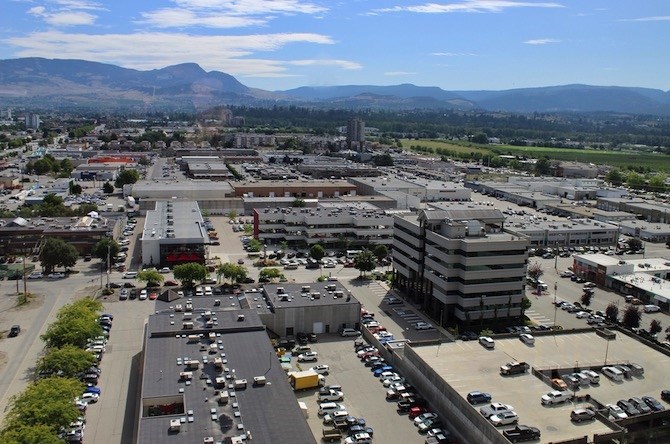
The taller building on the right is Landmark 1.
(ROB MUNRO / iNFOnews.ca)
“Back in the day, I think, the city didn’t want office towers here,” McAnerney said. “They wanted them downtown. That was a bit of a controversy.”
The land-use contracts overruled the “underlying” zoning that any city wanted to impose. It also freed a developer from having to pay development cost charges or get development permits that gave the city a say on the form and character of the buildings.
That doesn’t mean the city had no leverage. In fact, Stober ended up paying, or “gifting” the equivalent amounts of development costs charges to the city.
Still, it took 20 years for the first Landmark to be opened. That was in 1994 as a seven-storey “tower” with 64,000 square feet of office space. That was back in the day when few buildings in Kelowna rose more than four storeys.

Dallas Gray, Landmark’s marketing agent, commercial properties.
(ROB MUNRO / iNFOnews.ca)
“I think it was full right away so that’s why Al started Landmark 2,” Dallas Gray, Landmark’s marketing agent, commercial properties, said.
That was 11 storeys and opened in 1996 with 117,000 square feet of space.
So what made it attractive back then for business offices to relocate that far away from downtown?
“Parking, parking, parking,” Gray said. There are currently about 2,000 parking spots at ground level of Landmark as well as in a number of parkades, both for tenants and visitors.
The first two buildings are both on the north side of Dolphin Avenue and now stand separate from the bigger cluster of 3, 4 and 5 with their gleaming glass walls on Dickson Avenue next to Highway 97 and the city’s first (and so far only) pedestrian overpass (that Stober contributed $500,000 toward).
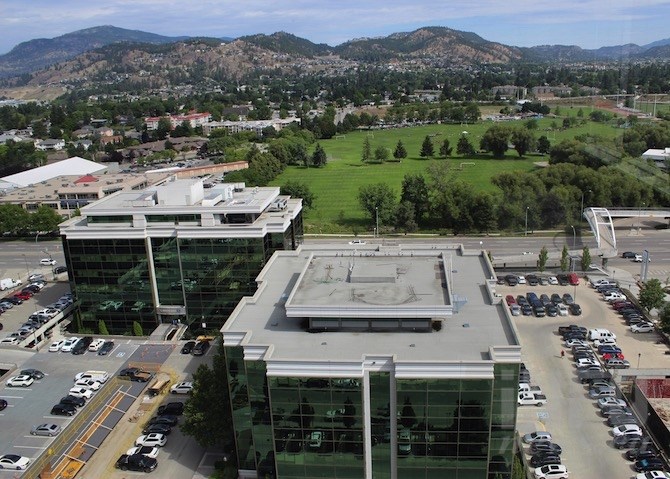
Landmark 3 in the foreground, Landmark 4 behind with Parkinson Recreation Centre across Highway 97.
(ROB MUNRO / iNFOnews.ca)
Those sit on land that was outside the land use contract boundaries so the city had more of a say on things like roads and sidewalks.
“The standards they originally built the roads to were the standards that existed back in the 1970s,” Ryan Smith, the city’s community development department manager said. “They have done upgrades above and beyond those in recent years to bring the neighbourhood up to a higher standard. With Landmark 3, 4 and 5, they built better frontage improvements and they built, finally, on Dayton Street, a sidewalk on one side.
“Council has been holding them accountable to a higher standard for development. Some of it is beyond the Land Use Contract. We’ve worked quite a bit with the Stobers on that road network and they’re on board to eventually achieve the road network that’s shown in the Capri/Landmark plan.”
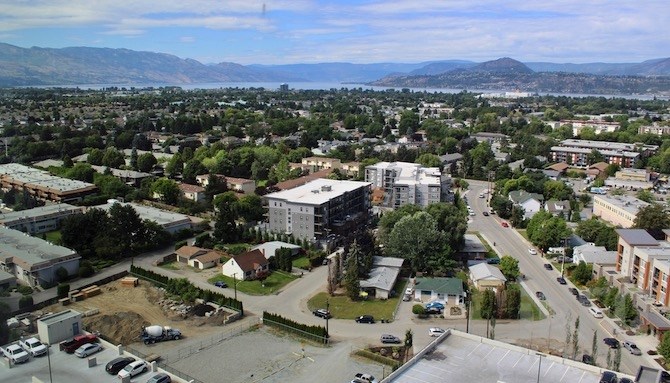
The two taller buildings are the The Flats rental units. A realigned Sutherland Avenue will cur in front of them.
(ROB MUNRO / iNFOnews.ca)
That includes a re-alignment of Sutherland Avenue to connect to Spall that will cut into a building Stober owns just behind the parkade for Landmark 6.
That 18-storey tower opened in 2012 with more than 200,000 square feet of what is no longer totally office space. It was, again, built on land within the Land Use Contract.
Today, Landmark has six buildings with a total of 58 floors with about 2,000 parking stalls providing 700,000 square feet of office and retail space for about 3,500 employees.
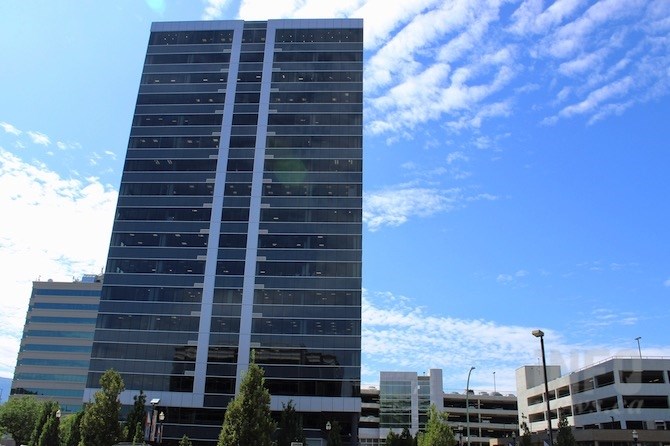
Landmark 6 rises 18 floors
(ROB MUNRO / iNFOnews.ca)
When the 23-storey Landmark 7 opens in 2022, that will grow to a total of 81 storeys with around 925,000 square feet, 2,500 parking stalls and 5,000 employees.
But, it’s no longer just office space.
Over time, the vision for the Landmark District has grown to include more street-level commercial outlets that now include more than a dozen places to eat. Even the first floor of Landmark 5 has been converted to retail.
Smith worked for the Mission Group in one of the towers in 2008 and remembers walking out the door and realizing there was no place close enough to walk to for lunch. Now, there are more than a dozen lunch options.
With the newly opened District Market next to the highway, there is a mini-food court with half a dozen food outlets. But it’s not a typical food court offering fast food from national chains but a hand-picked list of specialty eateries.
The new Landmark 7 will open in 2022 but may take four or five years to fill with tenants, Gray estimated. Construction has started but the marketing for tenants is still being prepared.
Gray pointed out that, unlike condo projects where a high percentage of units may be pre-sold before construction begins, there’s no money in office space until it’s rented out, so the return on investment takes years.
There’s probably no other developer in Kelowna, other than Stober, who could afford to take on such a massive project, he said.
This latest tower is covered by the land-use contract that came with the Turner Volkswagen site, so it could be dedicated to offices, with retail on the first floor.
“Under the Capri/Landmark plan, the city would have preferred the introduction of some residential in a mid-rise or high-rise form in that property,” Smith said. “They are doing residential elsewhere, which is great for that neighbourhood. Work we have done shows this area is already very well served with office space and there is a large imbalance between that and residential living opportunities.”
Gray begs to differ, given that Landmark 6 is fully leased and there is scant space in the other buildings.
That’s one of the unique features of the centre, he added. Small start-up businesses can move in there then grow within the same complex given the high concentration of office space and size options.
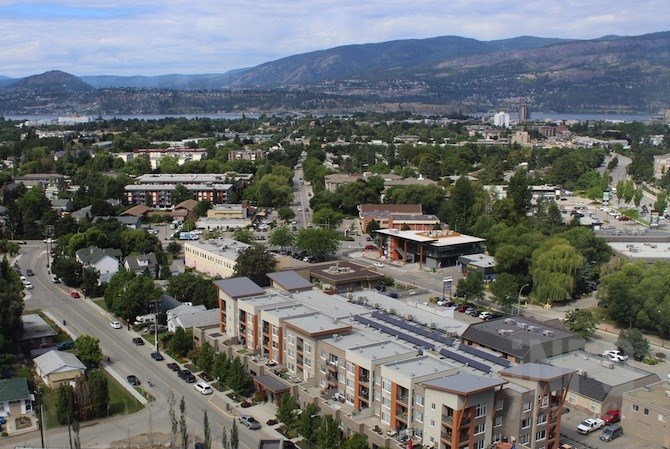
The taller buildings in the foreground are The Mode condominiums.
(ROB MUNRO / iNFOnews.ca)
And, as Smith said, Stober has built residential units. Those include about 170 rental units in two buildings called The Flats. Stober also partnered with the Mission Group to build a 90-unit condo complex called The Mode. More housing is in the long term plan but was put on hold while the Capri/Landmark plan was being drafted.
That plan covers the area between Gordon and Spall, Highway 97 and Springfield. It was held up last fall because of objections to the Sutherland Road realignment but was finally adopted April 1.
Any future tower will have to win the support of the city as the days of the land-use contract are coming to an end.
The province has set a 2024 deadline for all such contracts to be terminated. There are about 70 in the city that are slowly being terminated.
“Stober’s is one of the priorities over the next year or two,” Smith noted.
Even if it takes until 2024 to get that done, it’s not likely that Stober will be ready to start work on another office tower before then, Gray said. Besides, there’s not a lot of buildable land left within the boundaries of that contract.

Entrance to Landmark 6.
(ROB MUNRO / iNFOnews.ca)
To contact a reporter for this story, email Rob Munro or call 250-808-0143 or email the editor. You can also submit photos, videos or news tips to the newsroom and be entered to win a monthly prize draw.
We welcome your comments and opinions on our stories but play nice. We won't censor or delete comments unless they contain off-topic statements or links, unnecessary vulgarity, false facts, spam or obviously fake profiles. If you have any concerns about what you see in comments, email the editor in the link above.
News from © iNFOnews, 2019